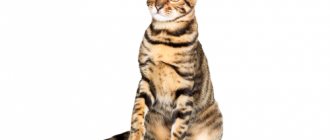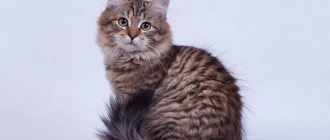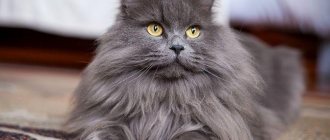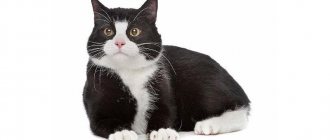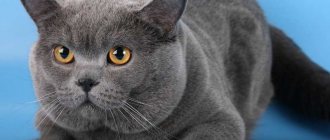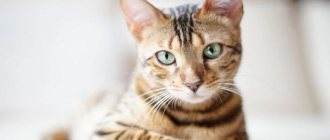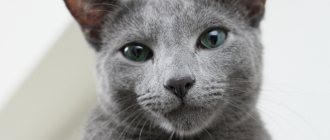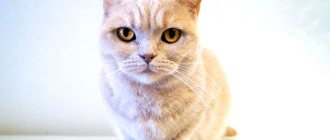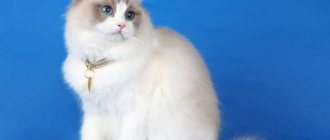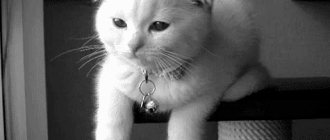Origin of brindle cat breeds
The cat family belongs to a group of mammals from the order Carnivora; they live all over the world. Domestication and artificial breeding of new breeds pleases us with the presence of a pet with an unusual color at home. A prerequisite is dark stripes and spots reminiscent of the coloring of a tiger, leopard or jaguar. Color - from yellow and sandy to dark brown. The body structure is reminiscent of predatory species of wild cats - a long tail, small paws, a head with a wide nose and a thin elongated body with a powerful neck. Miniature tiger.
Purebred breeds of brindle cats are bred only in official nurseries. On average, an adult weighs from 6 to 9 kg.
By the way, our domestic Siberian cat with thick fur that hides the true pattern is directly related to tiger cats. The weight of an adult pet reaches 12 kg. Very loyal to its owner.
Plain (solid)
The color of Scottish Fold cats is monochromatic and they should not have any other color. The fold-eared cat can be of the following colors: white and black, chocolate and lilac, blue and red, cream, fawn and cinnamon. The most popular color in the world among solid Scottish cats is blue. These are the majority of cats.
White
The white Scottish Straight cat can have different eyes, from blue and bright orange to rich amber and copper. Kittens of this variety remain white for the rest of their lives. If kittens have spots, then an adult cat remains white for the rest of its life.
Black
The Scottish Fold black cat is mostly bright in color. A couple of white hairs are acceptable, but if the cat has large red and brown patches, then it is not a purebred.
Black Scottish Fold cats should be bright black in color and their ears, like all fold-eared cats, should be pressed to the head, unlike straight-eared cats. A straight-eared black cat always has its ears erect.
Chocolate
The chocolate Scottish Fold looks impressive. The chocolate color is quite rare. Brown fold kittens should have a smooth, uniform coat of chocolate color. The dark brown coloring adds nobility to the cat.
A brown cat gets this color if he has chocolate, chocolate bicolor or chocolate color points in his pedigree. Chocolate Scottish kittens always delight their owners. They look very cool against a light background.
Lilac (lavender)
A lilac long-eared cat gets this color if he has either lilac color points or lilac in his pedigree. The lilac coloration goes well with orange, copper or amber colored eyes and a light brown nose. This color is also called coffee with milk.
Blue color (blue)
The Scots Blue can have a coat color of many shades of blue. Some cats may have a fur color closer to gray, and some closer to blue. Each hair must be saturated, then the coat will be perfectly blue.
Savannah
A relatively new breed that was recognized by the Cat Fanciers' Association in 2012, the Savannah is known for its unusual appearance. Large, tall ears are located on the top of the head. The savanna is also characterized by a long neck, long legs and a short, thick tail. In addition, these cats have exotic spotted and striped coats. And this is not surprising, the wild appearance of the savannah was achieved by crossing the African serval with a domestic cat.
All kinds of combinations
Spotting or striping may be presented in combination with a solid color. Monochromatic color is usually observed on socks or knee socks, spots on the chest, and stomach. Sometimes the tabby color spreads to the area of the paws, chest, neck, muzzle, and the rest of the coat is monochromatic.
Varieties and their descriptions
The most popular combinations are:
- blue tabby, with a gray or blue pattern on the main light background;
- tabby brown can be seen in the example of the British; cats have a black pattern on a chocolate background;
- Using the example of a Thai cat, you can get acquainted with the unusual seal tabby point color. Cream pets have stripes on the face, tail and paws, as well as light brown points;
- red-silver tabby suggests a base creamy-silver coat color and a reddish pattern on it;
- British kittens with silver fur may have a black tabby pattern;
- silver in combination with gray can also be observed in British cats. Tabby coloring involves a darker pattern on a light background.
Asian tabby
The brindle pattern is found among both short-haired and long-haired felines.
The Asian tabby cat is an animal with an exotic tiger color. The color of the coat can reach gray and silver shades, not at all reminiscent of its predatory counterpart. The formation of kittens' coloration can take from several weeks to two to three months. Purchasing an expensive friend is only possible at a specialized breeding farm upon pre-order.
The cost of a pet depends on the pedigree history, color contrast and characteristic pattern. Belonging to a certain class determines the final price. Pet class with differences from the standard color is estimated at 15-30 thousand rubles, Brit class with minimal errors in the standard - from 30-40 without the right and up to 60-70 thousand with the right to further breeding. Show class is a brindle cat with an ideal pattern and the right to breed. It costs from 80 thousand.
Appearance
These cats are the embodiment of power and grace. Toygers are quite large pets, they have expressive facial features - a large chin, bright, attentive eyes, neat ears. Representatives of the breed have a peculiar physique. The body of these cats is somewhat elongated, the limbs are strong and slightly short, in general the cat gives the impression of a strong and agile pet.
Cat Toyger
The main feature of these cats is their specific striped color. Dark, clear stripes stand out well against a light background and form a beautiful pattern, which makes these cats look like little tigers. This color is called tabby mockerel, but Toygers have their own version of this coat pattern. The stripes are located on the torso and limbs, as well as on the head. Neat elongated spots are acceptable.
Toyger cats are short-haired. Their hairs are soft, silky, with a very beautiful silver tint. The vibrissae (sensitive hairs) are quite long and thick, and the anus are dense, which gives them a somewhat menacing appearance of a predator. Despite their exotic wild appearance, Toyger cats are gentle, friendly, and this is easy to read in their facial expressions.
Breed standards
Body: powerful, medium length, muscular, without signs of refinement with dense bones. The chest is wide. The front of the body is weighted, the back is light. The weight of males ranges from 6 to 9 kg, and females 4-6 kg.
Coat: short, dense, soft, silky, shimmering. Contrasting vertical tiger stripes on the body (modified tabby), muzzle, paws, tail; the fur on the stripes may be slightly longer than the main background, this creates a visual volume of the pattern. The belly and the inside of the limbs, the underarms, the chin, the outer part of the cheeks and the neck are lightened, but painted. The fur on the underbelly is thinner and longer. The facial tiger stripes should be aligned in a circle. The external arrangement of tiger markings should tend to the natural color of the tiger.
Head: wide cheekbones, long muzzle. The corners are rounded. The chin is strong and deep. In profile, the head resembles a hexagon, the corners pass through the control points of the back of the head, forehead, nose and chin. There is thick, slightly elongated hair on the ears, temples and cheeks.
Eyes: small in size, expressive, located at an angle to the ears and outlined with a black edging. It is advisable to lighten the fur around the eyes.
Nose: the lobe is black, the nose itself is wide - it begins narrowed and widens at the end, rounded in the middle and slightly flattened at the end, long.
Toyger. Description
An elite of cats, ideally similar to the powerful "big brother". The name comes from the word "tiger". The Toyger breed was developed by selective breeding by mating a Bengal cat and an outbred Indian cat. It has the perfect transverse stripes characteristic of tiger skin. Representatives of the breed have the muscular build of a wild cat and weigh up to 7–8 kg, while cats weigh up to 5 kg. The animals have a wide chest and strong legs, perfect color contrast.
Reproduction in nurseries of this breed is strictly controlled by the owner. The toyger was officially recognized in 2007; the animals are considered rare and valuable. You can buy a kitten for a price of 1 to 2 thousand dollars (approximately 65-130 thousand rubles) depending on the color received at birth. Catteries sell pre-sterilized felines for home keeping. Selection work to breed the ideal miniature domestic tiger continues.
Types of wool
You can understand what breed a domestic kitten or an adult cat belongs to by the length and structure of the coat. The coat of different cats can vary greatly.
Longhair
Cats with long hair look especially elegant - it is no coincidence that they were once considered a kind of symbol of wealth and luxury... And even now, even despite the specific difficulties of care, these “fluffy creatures” remain popular pets all over the world.
The following cats have long, thick hair with a densely packed undercoat:
Longhaired Himalayan cat
- The Himalayan cat has thick and long hair, a Siamese color with a light body and darker muzzle, paws, ears and tail, a characteristic “flattened” muzzle with exceptionally blue eyes, a rounded but strong body with short and muscular limbs.
- Napoleon. The breed, already familiar to us, can do a “baby face” and this wins thousands of hearts.
- Norwegian forest cat. The standard wardrobe of this breed is long hair, mandatory sideburns, trousers and a winter collar.
- The Turkish Van has a silky coat of medium length without a thick undercoat, shorter on the neck and shoulders, but longer on the “panties” and tail, an elongated and muscular body with a well-developed chest and strong limbs, pink paw pads, and tufts of hair between the toes.
- Turkish Angora - semi-long silky coat, practically devoid of undercoat, large ears with straight outer contours and pointed tips, set high and close, an elongated “dry” body with a wedge-shaped head, elongated and slender legs and a long tail, blue (but possibly multi-colored eyes ) almond-shaped.
- The Persian cat has a long (up to 12 cm), thick and silky coat (on the neck, shoulders and chest there is a lush collar), a squat build with short and muscular legs, a characteristic “flattened” face, on which a small, wide and snub nose
- Neva Masquerade - thick and long hair, lush “pants” and a perfectly furred tail, “heroic” physique with strong limbs, necessarily blue eyes of various shades (from light to sapphire), Siamese color with a characteristic “mask” on the face (and with age “markings of a dark color” – also on the tips of the paws, ears and tail).
- Maine Coon - long and thick hair that fits tightly to the body, large ears with sharp tips, decorated with “tassels” and located at the very top of the head with a “square” shape, a large body with a wide chest and muscular build, a large head with “lion outlines” "(especially in cats), long fluffy tail.
- The Burmese cat has beautiful silky hair with a thick mane on the neck and wavy belly cover (lighter than on the back and limbs), a characteristic color (reminiscent of a Siamese) with dark paws, muzzle, ears and tail and white “socks”, strong and massive body with a wide and rounded head, round eyes necessarily sky blue.
- The Somali cat has long hair of a very soft and delicate structure, shorter on the shoulders, large, alert ears with a wide base, moderately pointed tips and the inner surface of the auricle covered with tufts of hair, medium build with well-developed muscles and a “fox” tail.
- Nibelung - soft, medium-length coat of solid blue color with a distinct silvery tint, with a thick undercoat and not very noticeable collar and “pants”, slightly elongated and muscular body with long limbs and tail, straight nose with a blue-gray lobe, large widely spaced eyes oval in shape and rich green (possibly amber) color.
- Ragamuffin - a dense, but at the same time smooth and silky “fur coat”, a kind of mane around the neck and outer edges of the muzzle, highly developed decorative hair on the neck and hind legs, a thick tail at the base, covered with long and dense plume-type hair, a powerful physique with a pronounced fat pad on the abdomen, bright and rich eye color (regardless of color).
What to feed?
Tabby cats cannot stand monotony in their food. You cannot feed such a cat with dry food alone. You need to regularly change the type of meat, alternating, for example, chicken with beef and fish. Otherwise, the owner risks throwing the cat's lunch in the trash and being left alone with a hungry predator.
The diet must include fresh meat, live food, mineral and vitamin supplements.
The issue of nutrition is fundamental in keeping animals. The diet should be selected depending on the breed, taking into account the advice of experts.
- The toyger has good health and experts do not give any special recommendations for feeding it. It is sometimes recommended to offer solid food to prevent dental disease.
- Bengal cats also have good health, their life expectancy is up to 15 years. Such expensive animals, as a rule, are fed either high-quality natural products - fish, meat, or expensive cat food with vitamins.
- Tender Sokoke are advised to be kept on a balanced diet with vitamin E and taurine, as their heart and metabolism may be weak.
- Mau often suffer from allergies, asthma and heart problems, so they especially need special food for this breed. If your cat has a tendency to these ailments, be sure to feed your pet correctly.
- Posh Ashers are recommended to be given natural products - high-quality beef, poultry, ocean fish, and leave dry food as an additive to the rest of the diet.
- American Shorthair cats love to eat, so that this does not lead to problems, it is recommended to feed them twice a day, and not on demand. Don’t forget to occasionally pamper them with dietary boiled meat, they love it very much.
- If you take up keeping munchkins, then depending on their age, experts advise feeding them 2 to 5 times a day: kittens - more often, and older animals - less often. Babies who are only a few months old are advised to give cereals, dairy products, meat, while adults can be switched to regular food, wet or dry.
- Siberian cats can be very large, and it is important to correctly calculate the amount of food. Typically, 30-60 grams of feed are given per 1 kg of weight. To make the coat look beautiful and shiny, up to 3 years of age, a diet containing 70% protein is recommended.
Breeding
If we talk about breeding Siberian cats, then it is quite easy to purchase them in nurseries or from breeders. As for overseas beauties, some breeds can only be found in a few nurseries, and you will have to pay a considerable amount for such exotics.
Toygers cost from 1 to 3 thousand dollars; an individual capable of giving birth to kittens will cost twice as much. They can be bought in official nurseries in Moscow, St. Petersburg, Zelenograd. Mau is not a cheap breed; it costs up to 100 thousand in the official nursery in Moscow. Sokoke, which require quite a lot of care due to health problems, can cost the same price.
The most expensive are Asher cats, the price for them can reach one and a half million rubles or 20-30 thousand dollars if it is a kitten with documents.
The choice of cat depends on your wishes and needs. Purebred animals become a source of pride for many, but they often really need special care and expensive specialized food, since they do not have such good health as the ordinary “murki” that have lived in our country for generations. You need to weigh your options in order to provide your purebred pet with the proper conditions.
An overview of the Toyger cat is presented in the following video:
Sokoke. Description of the breed and its representatives
Medium sized Sokoke cat with marbled tabby pattern on a sandy background. The ears are large with tassels. The slanted look gives an original expression to the face of the graceful representative of the Kenyan forests. Sokoke is the forest African ancestor of Asian cats. The breed was registered in 1993. A distinctive feature of the tiger cat's coloring is the presence of a necklace around its neck. The color of the skin, similar to the bark of a tree, makes it distinguishable from other subspecies.
A miniature copy of a cheetah has a restless character and irrepressible energy. Strong attachment to the owners and playfulness will make the pet unhappy if its owners are constantly absent or busy with work. Sokoke is ready to play around the clock, which is suitable for families with small children. Hide and seek, chasing and constant movement around the apartment are what an active animal needs. African origin makes itself felt with the onset of cold weather, which is difficult for this heat-loving breed to tolerate.
Buy | sell
| Zelenograd29 May 2019 Greencity nursery offers Toyger and Bengal kittens. The babies are raised in the family circle, transferred to the new owner after the necessary… |
| March 10, 2019 Greencity nursery offers Toyger and Bengal kittens. The babies are raised in the family circle, transferred to the new owner after the necessary… |
| 50000 MoscowDecember 14, 2018 The nursery sells the Simona cat of the Toyger breed - one of the very rare breeds in Russia and the world. "Toyger" - translated from English - "toy tiger" ... |
| I'll give it to good handsMoscowJanuary 27, 2018 Moscow and Moscow Region A very young, miniature, smooth-haired Diana, affectionate and tame, purring, wonderful girl. Lives in a cage in a shelter, with a rare… |
| 300 EkaterinburgDecember 14, 2017 Kittens 1.5 months old. . They eat everything. Playful, slightly fluffy, very affectionate, purring. If they grow up to be real hunters in their home. Black boys... |
| I'll give it to good handsEkaterinburgOctober 9, 2016 An active, smart, neat cat offers himself as a healer, sleeping pill, heating pad, performer of musical purrs, master... |
| 100 Tashkent8 October 2015 adorable kittens 1, 5 months old and cats 2 years old, red cat 1 year old. good hunters and friends of man, calming and supporting in difficult times... |
| 25000 September 21, 2015 Affectionate Toyger kittens are looking for their owners. Trained to the tray and scratching post. Active, friendly, playful. The kittens are officially registered... |
| 60000 Moscow8 September 2015 Kittens of the TOYGER breed with the bright appearance of a tiger cub and a sweet, affectionate character are offered by the FairyBerendey nursery. They will become the best comrades in... |
| 30000 September 1, 2015 Toyger kittens for sale in classic (brown) and exotic colors (silver, mink), boys and girls of different ages, vaccinated according to age, ... |
| 60000 Moscow25 April 2015 FairyBerendey nursery offers Toyger kittens and cats. These are bright, cheerful domestic cats. Indoor tiger cubs will delight you and your children... |
| 40000 MoscowNovember 7, 2014 Kittens of the TOYGER breed with a bright tiger cub appearance and a sweet, affectionate character. There are kittens of traditional color and white tiger color. They will become... |
| 55000 St. Petersburg4 June 2014 We offer Toyger kittens from the largest Toyger nursery in Russia. We have kittens of different price categories, call us and we will definitely find you... |
| I will buy May 19, 2014 |
| 77000 Moscow May 15, 2014 Charming Toyger kittens for sale, the babies are 3 months old, they will be ready to move in 2 weeks with all the documents! |
| 1 I'll give it to good hands St. Petersburg July 18, 2013 I’m selling a kitten, from our cat, looks like a toyger (“toy tiger”), 3 months old, litter box trained, eats everything, very active and affectionate. ONLY left... |
| 20000 ObninskFebruary 9, 2013 Wonderful kids are getting ready to move to new homes. There are boys and girls. The children are well-mannered, active, very playful and inquisitive. ... |
| 20000 KalugaFebruary 9, 2013 Wonderful kids are getting ready to move to new homes. There are boys and girls. The children are well-mannered, active, very playful and inquisitive. ... |
| 20000 TulaFebruary 9, 2013 Wonderful kids are getting ready to move to new homes. There are boys and girls. The children are well-mannered, active, very playful and inquisitive. Toygers... |
| December 18, 2010 |
Pixie bob
To develop a breed of cat that resembles a lynx, breeders used short-tailed forest cats. These animals live in the forests of North America. The first cat obtained in this way was named Pixie, which means “Elf” or “Fairy” in English.
The animals are distinguished by a short tail, tufts on the ears and whiskers are possible. Pixies are unpretentious, train well and easily make contact with people.
Bengal and Egyptian Mau
The Bengal breed was the result of artificial mating of a wild leopard cat with outbred Californian cats in 1963. The breed was registered in 1983 and is more common than the Toyger.
Egyptian Mau are spectacular cats with short hair and slender legs, with the grace of a queen and large eyes. The four subspecies include smoke and silver with black spots, honey and sand with brown leopard patterns.
When a sacred pet died in ancient Egypt, it was buried with honors in the family crypt or in a separate animal cemetery. The embalmed feline was accompanied to another world by mummified mice.
Interesting Facts
- In ancient Egypt, when a cat died, all members of the owner's family shaved its eyebrows and mourned it. They buried the animal with honor, and during the procession they drank wine and beat their chests. The Egyptian Mau was embalmed and placed in a family tomb or animal cemetery with miniature mouse mummies.
- Toyger is the youngest breed of tiger cat. It was developed based on the requirements of modern life: the animal must become a friend and companion to the owner. So the toyger cat is a design development of breeders. By the way, they continue to be improved with the goal of making them completely similar in appearance to tigers.
- Wild oncilla is almost never kept at home. Only isolated cases of domestication of a predator are known, and their owners keep them not in houses, but in enclosures.
- Tiger cats, unlike many, can speak with their eyes. Their emotions and feelings are immediately imprinted in the expression of their muzzle, and it is quite difficult to distinguish one emotion from another, since they are caricatures.
- And finally, we want to give advice to those who want to have a tabby friend: under no circumstances let your cat go wild. These animals need constant displays of affection and love more than others. Otherwise, they will become withdrawn and even aggressive.
Video
British and American breeds
The brindle color of the British cat attracts many breeders. Representatives of this breed have an obstinate character and the appearance of a fabulous Cheshire cat. The animal requires a lot of free space for constant movement and a separate place for privacy. The purchase price at the nursery is about 10 thousand rubles.
The American Shorthair is an active and strong cat, ready to jump and play all day long. Tiger stripes can be any color. Long-lived among domestic cat species.
Why a purebred pet?
Choosing a pet is not an easy task. Nowadays it has become popular to purchase purebred cats. Each breed is beautiful and graceful in its own way, plus, with such a cat you can take pride of place at the exhibition. But you shouldn’t judge a cat by its appearance, it should suit your style and lifestyle. The catalog contains a lot of useful information about animals: appearance, temperament, necessary care. Representatives of the Persian and Angora breeds require special care, but they are not so dependent on human interaction. Are you at home most of the time and want some fun? Buy a Siamese or Abyssinian cat. If you have small children at home, you need a pet with a lot of patience in order to withstand all this squeezing. A British or Scottish cat would be a good nanny.
Diversity of the cat world
The world of cats is diverse. They differ in color, eye shape, fur length, character and other equally important criteria. There are a large number of organizations involved in developing standards and registering breeds. How a relationship develops with a pet depends on the person. For a cat, the owner is the most adored person on earth; his betrayal will leave a scar on the animal’s soul. For humans, a cat is a healing salvation from depression and bad mood, a fluffy little ball that can warm the heart on the coldest evenings.
Scottish cat and munchkin
Scottish brindle cats are characterized by a marbled tabby color on the back and a large M-shaped mark on the forehead. Yellow eyes and small ears characterize this breed. It is estimated at an average of 25 thousand rubles.
The short-legged munchkin is often found with striped coloring. The shades of his stripes come in different colors. Very active and playful, loves to be in the company of small children. Its short legs make it look like a dachshund. This breed has been known since the 90s. You can purchase it from a farm for breeding animals at a price ranging from 5 to 20 thousand rubles.
Interesting photo
Calm grace
Yes, it's a tiger, just a small one
After games you need to rest
Before the jump
Handsome Toyger on a green background
Character of domestic "tigers"
The character of a brindle cat is as varied as the patterns on the animal’s skin. Representatives of cats are emotional, which is immediately noticeable by the expression of their eyes and muzzle. They are very active, adapt quickly, inquisitive and intelligent.
The hunter's instinct manifests itself in a constant search for game; sometimes the animal stores food for future use. Night movement around the apartment is dictated by nature's inherent need for safety.
But not all cats have this character. Some breeds, such as the Scots and the British, are very calm and even-tempered. Before purchasing an animal, be sure to consult the breeder. He will tell you about all the features of the breed and the character of the kitten you have chosen.
How to care
Caring for tiger cats is the same as for other breeds. They need to be fed in a balanced manner.
The basis of the diet should be raw meat, it is advisable to alternate different types: veal, chicken, beef.
You can also feed raw sea fish and boiled river fish. The diet should contain vitamins and mineral supplements. If you feed with industrial feed, then only premium quality.
We suggest you familiarize yourself with: Mollies balloon propagation
Once a week, remove excess hair with a natural bristle brush and clean your pet's ears. Swimming should be done once a month.
Nails are trimmed once a week with special scissors. Visits to a veterinarian (vaccination, deworming) are required.
Brindle cats are known for their cleanliness and for this reason it is necessary to clean their litter box as regularly as possible. Wood shavings are suitable as a filler. It is better to choose a tray with high edges to avoid spillage of the filler when buried.
The animals are active and benefit from daily walks. It would be good if there was a special climbing complex at home. The higher it is, the better.
Features of caring for a tiger cat depend on the length of the coat and lifestyle.
The first rule for owners is mandatory annual vaccinations and supporting the body with vitamins.
Due to their “wild” origin, tiger cats are often very active. They are constantly in search of new and interesting things.
Sometimes they even go on such a spree that they don’t come home to spend the night. And all thanks to the fact that the hunter’s instinct is highly developed in them. They need to wander down the street at least sometimes in search of mythical prey.
The consequence of such a spree is often parasites, such as fleas. Therefore, owners need to carefully monitor this.
The rest of the care for a tiger cat is minimal: you need to comb it once a week and sometimes trim its claws.
Basic methods for determining the sex of a kitten
There are several methods for determining the sex of kittens. Most cat lovers determine their gender visually:
- according to the shape of the genitals;
- by coat color;
- by habits;
- by physique.
In addition, if you have experience, they use the method of palpating the testicular primordia in the space between the anus and the urethra.
Cryptorchidism in cats
The first method is to determine the sex of a kitten based on the outline of the genitals.
The appearance of the anus and genitals is described above for newborn kittens and animals one month old. In order to examine their structure, the kitten is carefully turned tummy up. Another way is to place the baby on the diaper with his back up and lift his tail.
Sex differences in young kittens
The second method is to differentiate kittens by coat color.
Regarding coat color, the only thing that has been reliably proven is that only girls can be tricolored. The combination of white, black and red colors is determined genetically. This color is due to two X chromosomes from the female set of chromosomes. The so-called “tortoiseshell” color is also found only in females. It is believed that red fur is a sign of male gender. And, indeed, most often male cats are red, but there are also females. Therefore, one should not judge gender by their red color.
Who is the cat and who is the cat?
The third method is palpation
The gender of the kitten is determined by palpation from birth. Palpation is carried out carefully so as not to cause pain to the baby. This is done with two fingers (middle and index) in the part of the body between the urethra and the anus (as shown in the photograph). In boys, “peas” with a diameter of about five millimeters are palpable. These small balls are located symmetrically, the hair in their place grows in a different direction than on the entire body of the animal. The color of the coat is also different. In girls, this area is perfectly smooth, without knots or differences in the characteristics of the coat.
Determining the sex of a kitten using palpation method
IMPORTANT! For this method, the experience of the examiner is important. The female may have swelling due to various reasons. And the testes of males are up to a certain point in the abdominal cavity of the kitten and are not detected during palpation
And the testes of males are up to a certain point in the abdominal cavity of the kitten and are not detected during palpation.
The fourth method is to determine the gender of cats by body type
In appearance and physique, differences appear in kittens at six months of age. The cat's body is large and powerful. The body of a cat is more graceful and smaller than that of a cat. The female's head is visually smaller than the male's.
External differences between cats and cats
The fifth method is observing the habits of animals
Differences in the habits of cats and cats appear during puberty. At seven months the male begins to mark his territory. The female begins her first heat at this age. The cat arches its back, raises its tail, and demands affection.
Cat in hunting mode
As adults, cats behave calmer than cats. Males often sleep, and females are “cats who walk by themselves.” Cats are cleaner than cats. They wash themselves constantly and always go to their own toilet. Cats often ignore the toilet they are accustomed to.
The cat calls the cat
Additional care
Artificially created varieties of the tiger breed are highly prized. Genetic studies prove a direct connection between the genes responsible for body color and the animal’s immunity. Selected cat breeds, despite the fact that their wild counterparts have excellent immunity, require additional attention to the nutrition and care of the pet.
The need for annual vaccinations and additional vitamins is mandatory for valuable representatives of the feline class. Monitoring the health of the eyes, heart and blood vessels will allow timely prevention of possible disease.
Representatives of many tiger breeds are long-lived; their lifespan is about 20 years with proper nutrition and lifestyle. The need for walks in the fresh air obliges the owner to think through ways and times for such activities.
Health
Typically, wild-type animals are very resilient and disease-resistant, unlike their bred counterparts. Modern genetic studies have shown that the T gene, which determines the brindle color, is directly related to immunity.
We invite you to read: The main difference between food for sterilized cats and regular food: how to choose
Artificially created breeds, more than the descendants of their “wild” counterparts, are susceptible to diseases such as:
- cardiomyopathy;
- cardiac hypotrophy;
- cataract;
- feline leukemia.
The rest of the “tiger cubs” mostly suffer only from the same diseases that ordinary domestic cats suffer from:
- colds;
- infections;
- poisoning
Peculiarities
Tabby cats can have different patterns and patterns, as well as different shades of fur. Some wear fur coats resembling tiger print, others wear leopard print coats, and still others have a mixed pile pattern. Some species of tiger cats still live in the wild, but the majority have long been domesticated. There are also artificially created breeds that are quite expensive. First, let's tell you in a few words about wild animals that are the ancestors of domestic purrs.
There are three main subspecies of tabby wild cats:
- northern tiger , which originally lived in Brazil and Venezuela;
- southern tiger, its main habitat is Brazil, Paraguay, Argentina, Uruguay;
- The leopard spotted leopard is found primarily in Western Venezuela and Ecuador.
Some lovers of exotic animals try to keep wild cats such as the serval and ocelot at home, but perhaps the oncilla has the most unusual appearance. And this is not surprising, because unlike other cats, she has not 38 chromosomes, but 36. She loves an active night life, and during the day she tries to sit on elevated surfaces, from where she can assess the situation and keep it under control. In short, you cannot grow a cute tame fluffy from an oncilla, and it should be kept in a spacious enclosure.
Their population is not large, the oncilla is recognized as a vulnerable species and is included in the CITES trade convention, so it is not easy to buy such a cat.
Domesticated and selectively bred animals are much more suitable as favorite pets.
Among them there are also very unusual species that can become a source of pride for owners, such as mini-tigers (toygers), Bengals and other tiger cats.
Nutrition
The diet of a domestic predator should be varied, it includes meat and lactic acid products, vegetables, and vitamin supplements. Unable to tolerate a monotonous diet due to their being natural hunters, tiger individuals consume only fresh, nutritious food. Long-haired cats that undergo seasonal shedding require additional care. Frequent bathing is not particularly recommended; animals clean their own fur.
Striped felines have become so close to humans that life without them becomes boring and uninteresting. But it’s not always worth “chasing” a breed. Any stray cat can turn into a gorgeous, handsome cat, feeling the care and affection of its owner.
Conditions for keeping
Tiger cats, like other pets, require the care and attention of their owners. Living conditions for all domestic felines will be similar. It’s good if the animal has its own corner in the house, where there will be objects for games and a scratching post. Cats usually remember places for food and toilet quickly. These pets are very clean, but most of them do not like water procedures, and experts still recommend washing domestic cats about once every 2 months.
Combing the fur will also not be superfluous.
